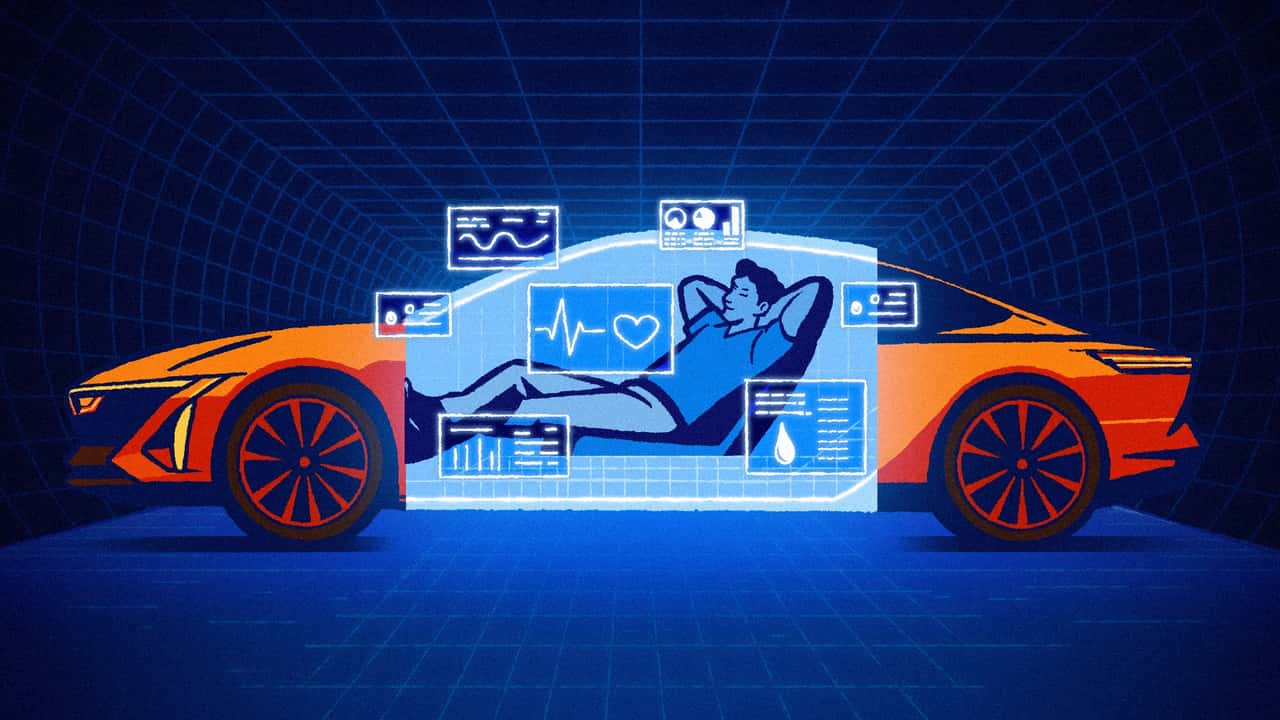If it were up to Cadillac, steering wheel displays and biometric monitoring would be tomorrow’s must-have luxury car features.
The automotive industry is at an inflection point. Software has changed what consumers expect from today’s vehicles, and the increase in processing power unlocks new possibilities. Screens, connectivity, advanced safety features, and autonomy are changing how automakers think about and design tomorrow’s vehicles.
It’s certainly no easy task for a car company to try and predict what consumers might want, or what their competitors might offer—but Cadillac is trying nonetheless.
Cadillac’s latest concept—the Elevated Velocity—is proof of that. Packed with cutting-edge technologies and far-flung ideas, Cadillac aims to decipher what we, the consumers, might want from our luxury vehicles five, 10, or even 15 years from now. It’s an interesting idea.
With electric cars democratizing horsepower, the number of characteristics that can differentiate mainstream products from luxury ones dwindles. Software allows automakers to tailor their ownership experience, and Cadillac is thinking about every possible feature one could ever want in an autonomous future.
Cadillac Elevated Velocity Concept
Bryan Nesbitt, General Motors’ vice president of global design, said during a media backgrounder for the concept in August, “We’re very interested in understanding, studying, and solving how to bring more value to the customer while the vehicle is in self-driving mode.”
The company wants to use technology to “unlock those experiences” for customers.
“And at the same time, do they want to still maintain some exhilaration?” he added. Elevated Velocity doesn’t remove the driver from the equation—instead, it gives them a choice. We hope it doesn’t result in a world where being able to drive your own vehicle is a luxury in itself.
“Do they still want that hands-on experience and that excitement that’s delivered from being in control at that moment?” said Nesbitt. “We’re suggesting that sounds like a pretty great combination, and that’s a lot of what this exploration is about.”
Cadillac’s latest study goes far beyond just features and amenities. The automaker is also asking big questions about how the future of mobility could look.
Autonomous vehicle technology continues to progress, including General Motors’ hands-free Super Cruise driver-assist system. Elevated Velocity is the testbed for Cadillac to understand how it can allow drivers to repurpose their time behind the wheel when the computer takes control.
The concept, like its 2024 predecessor, features integrated biometric sensors that track heart rate, oxygenation, and stress. Cadillac designed the concept to aid in breathwork and relaxation while the car drives itself, but it’s easy to see how the company could repurpose that tech into a full-blown health monitoring system.
There is a future where your watch, your earbuds, and your car all remind you how unhealthy you are. But it could also save the life of someone experiencing, or about to experience, a medical episode while they’re driving.
“We know we can collect the biometric data,” said Nesbitt. “How can it really be used?”
The company’s InnerSpace concept from 2023 heavily focused on the in-car experience, featuring a massive panoramic LED display that obscured most of the windshield and allowed passengers to control vehicle functions and access entertainment.
At the time, Nesbitt said, “Electrification and autonomous driving will fundamentally change the role of vehicles and the experiences customers have with them,” and it’s something the automaker continues to explore to this day.
What may constitute a luxury feature a decade or two down the road is a mystery, and Cadillac doesn’t know either. That’s why these concepts exist.
Elevated Velocity is an opportunity for Cadillac to solicit feedback, and “test the waters and see if people think that this makes sense for the things that we’re investing in now and things we might maybe should invest in the future,” said GM’s design boss.
The Cadillacs we may see in the years to come could have some of the features previewed in this concept and other recent ones, like the steering wheel display and illuminated rims. The rims are admittedly closer to reality than the wheel, but Nesbitt has his team trying to turn the steering wheel display into a production piece.
Cadillac designed the wheel to display information, like speed, time, and battery, because the concept lacks traditional displays. While automakers today can’t seem to cram enough screens into their cars already, including Cadillac, the brand is thinking about what comes next, like a full-windshield augmented reality head-up display.
Engineers still have a few things to figure out before the steering wheel display ends up in front of a driver, like fitting the airbags. But once that’s done, and if it’s achievable, it might be the brand’s first step toward a screenless cabin, if buyers want that. Nobody knows, and that’s what’s great about Elevated Velocity and Cadillac’s many other concepts—we see a bit of what’s possible today.
“How far can we take electrification and performance?” Nesbitt said, “How far can we take luxury performance as product experiences?”
It’s no surprise Cadillac makes no mention of the concept’s powertrain other than that it’s electric, which the company still believes is the future. The brand has the horsepower equation already figured out—the Lyriq-V is the brand’s quickest car ever, and it starts at just over $80,000. That’s not cheap, but it gets you a family SUV with 615 horsepower and a 3.3-second 0-60-mph time.
Future Cadillac models will have to offer more than just power and performance to stand out, but watching the brand attempt to predict that future in real-time is a fascinating thing in itself.
What We Think
We want your opinion!
What would you like to see on Motor1.com?
– The Motor1.com Team
